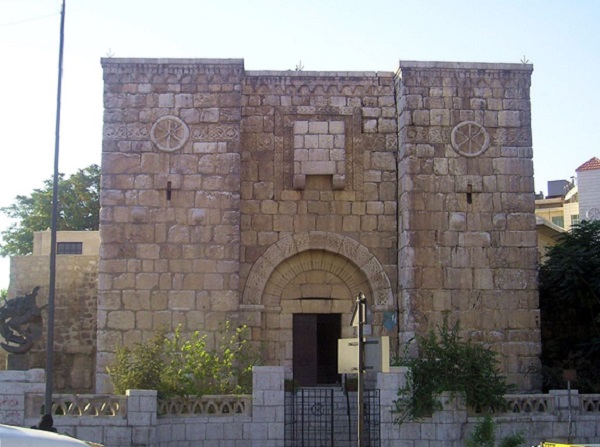The historian and researcher Salah Kharbatli told Syria Times news paper that after his baptism, St. Paul devoted himself to preaching in the synagogues, saying that Jesus was the Son of God confounded the Jews who lived in Damascus by proving that this one was the Messiah (Acts 9,20-22). In his biographical accounts, St. Paul tells us that soon afterwards he went to Arabia ‚ to the region south of Damascus called Hauran ‚ perhaps with the purpose of avoiding a confrontation with his fellow Jews. After one or two years he returned to Damascus, where he pursued his vocation to preach the Christian message.
The first reaction of the Jews was one of surprise: is not he the man who persecuted those who called upon that Name? Little by little, however, this reaction turned into opposition, and the opposition grew so strong and dramatic, that one day the Jews contrived a plot against St. Paul and were supported by those governing the city on behalf of the Nabatean king, Aretas IV. St. Paul learned about this plot, but since the Jews were carefully watching the gates of the city all day and night, the Christians took him by night and let him down from the walls in a basket. Recalling this episode, St. Paul says that it was through a window that he escaped from certain death (2 Cor 11, 32-33). In the same way the spies of Joshua, whom Rahab helped to escape from Jericho, were lowered from a window in the city walls (Josh 2,15).

Does any place still exist that recalls this hasty escape of St. Paul?
In those days the city of Damascus was surrounded by a wall. Going out through the Eastern Gate and keeping to the right, one passes a 400-metre stretch of the ancient city wall, which stops at the Kisan Gate, in front of the roundabout on the motorway to the airport.
The lower layers of this stretch of wall are composed of Roman-style blocks of stone, whilst the upper layers are mediaeval or more recent. One can also see houses built into the wall, with their windows and other smaller openings appearing in it. It is easy to imagine the scene of the escape:
how St. Paul, after being lowered from the wall, fled in haste down the road that leads to Jerusalem. This southeastern district of the city was not only very close to the start of the Roman road that St. Paul would have taken, but was also the part where, from the earliest times, the Christians used to live. It is very probable, then, that the scene of St. Paul’s escape was somewhere along this stretch of wall. In fact, the Christian tradition identifies a window beside the Kisan Gate, as the window from which St. Paul was lowered.
This gate, Bab Kisan, is one of the seven Roman gates of the city and was dedicated to Saturn. It was given the name of Kisan in memory of a slave who became famous during the Conquest, after being liberated by the Caliph Mu’awia. The gate has been sealed and then reopened and restored several times. It is to be noted that the blocks at the base of the gate are Roman, whilst the style of the arch is clearly typical of the Mameluke period. The Arabic historian, Ibn Assaker, says that the mosque situated in Darb el Baia was formerly the church of the Jews, and was converted into a mosque called Ibn Shahrazouri.
This, then, was one of the 15 churches in which the Caliph Omar allowed the Christians to gather and worship. A few years later, Ibn Kathir provides us with more information: the mosque restored by Sef ed- Din Boghaäis to be found inside the Bab Kisanäand originally it was a church. It was seized in the year 1122 and converted into a mosque.


From the 13th century onwards, pilgrims and travelers have left many accounts, according to which the window of St. Paul’s escape is localized to a point beside the Bab Kisan. However, none of these Christian accounts mentions the mosque. The first account we have is that of an anonymous Englishman (1244) who calls the gate Porta Santi Pauli. The Franciscan, Bonifacio di Ragusa, situates the Porta Santi Pauli in the place that the tradition identifies with the escape of the Apostle, that is to say near the Bab Kisan. After him, all the reports confirm the existence of a window beside the Bab Kisan, which was venerated as the place of St. Paul’s escape.
The local tradition adds that Paul was able to escape by the help of a Roman guard of Ethiopian origin, who was later condemned to death for this reason.
The mosque of Bab Kisan mentioned by the Arabic writers was restored in 1387, and from that time onwards there is no further record of it. In 1885, old and ruined, it was purchased together with the surrounding area by the Melkite Patriarch, Gregory Joseph. On this land a chapel was erected, whose walls incorporate traces of the ancient gate and a small section of the wall. It was inaugurated in 1939. The sober and austere design of this Sanctuary matches very well with the antiquity of the walls, forming a harmonious combination. Two elegant and modern ‘chi-rho’ monograms adorn the fortified towers that stand on either side of a fictitious window, similar in style to those of a mediaeval castle. Worried but joyful, St. Paul escaped from this place, taking the road that would lead him to Jerusalem, where for the first time he was to meet the Apostles. For St. Paul, how different must have been this return journey to Jerusalem, from his outward journey to Damascus!
 Adapted by: Haifaa Mafalani
Adapted by: Haifaa Mafalani

